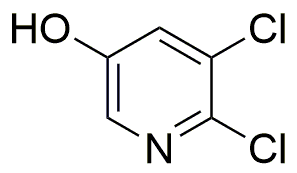2,3-Dichloro-5-hydroxypyridine is widely utilized in research focused on:
- Agricultural Chemicals: This compound serves as an important intermediate in the synthesis of herbicides and fungicides, helping to enhance crop protection and yield.
- Pharmaceutical Development: It is used in the development of various pharmaceuticals, particularly in creating compounds that target specific biological pathways, which can lead to new treatments for diseases.
- Material Science: The chemical is employed in the formulation of specialty materials, including coatings and polymers, where its properties can improve durability and resistance to environmental factors.
- Analytical Chemistry: It acts as a reagent in analytical methods for detecting and quantifying other chemical substances, making it valuable in quality control processes.
- Research Applications: In academic and industrial research, it is used to study reaction mechanisms and the behavior of chlorinated compounds, contributing to a better understanding of chemical interactions.
General Information
Properties
Safety and Regulations
Applications
2,3-Dichloro-5-hydroxypyridine is widely utilized in research focused on:
- Agricultural Chemicals: This compound serves as an important intermediate in the synthesis of herbicides and fungicides, helping to enhance crop protection and yield.
- Pharmaceutical Development: It is used in the development of various pharmaceuticals, particularly in creating compounds that target specific biological pathways, which can lead to new treatments for diseases.
- Material Science: The chemical is employed in the formulation of specialty materials, including coatings and polymers, where its properties can improve durability and resistance to environmental factors.
- Analytical Chemistry: It acts as a reagent in analytical methods for detecting and quantifying other chemical substances, making it valuable in quality control processes.
- Research Applications: In academic and industrial research, it is used to study reaction mechanisms and the behavior of chlorinated compounds, contributing to a better understanding of chemical interactions.
Documents
Safety Data Sheets (SDS)
The SDS provides comprehensive safety information on handling, storage, and disposal of the product.
Product Specification (PS)
The PS provides a comprehensive breakdown of the product’s properties, including chemical composition, physical state, purity, and storage requirements. It also details acceptable quality ranges and the product's intended applications.
Certificates of Analysis (COA)
Search for Certificates of Analysis (COA) by entering the products Lot Number. Lot and Batch Numbers can be found on a product’s label following the words ‘Lot’ or ‘Batch’.
*Catalog Number
*Lot Number
Certificates Of Origin (COO)
This COO confirms the country where the product was manufactured, and also details the materials and components used in it and whether it is derived from natural, synthetic, or other specific sources. This certificate may be required for customs, trade, and regulatory compliance.
*Catalog Number
*Lot Number
Safety Data Sheets (SDS)
The SDS provides comprehensive safety information on handling, storage, and disposal of the product.
DownloadProduct Specification (PS)
The PS provides a comprehensive breakdown of the product’s properties, including chemical composition, physical state, purity, and storage requirements. It also details acceptable quality ranges and the product's intended applications.
DownloadCertificates of Analysis (COA)
Search for Certificates of Analysis (COA) by entering the products Lot Number. Lot and Batch Numbers can be found on a product’s label following the words ‘Lot’ or ‘Batch’.
*Catalog Number
*Lot Number
Certificates Of Origin (COO)
This COO confirms the country where the product was manufactured, and also details the materials and components used in it and whether it is derived from natural, synthetic, or other specific sources. This certificate may be required for customs, trade, and regulatory compliance.


